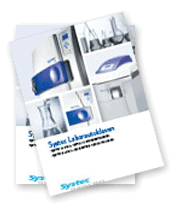Horizontal bench-top autoclaves Systec D-Series
The Systec D-Series are front-loading, bench-top autoclaves available in 7 sizes with chamber capacities ranging from 23 to 200 l. Compact on the outside but with ideal chamber capacities inside. Each size has an optimal loading capacity for most standard media bottles and Erlenmeyer flasks.
Two model ranges with different performance.
Systec DX
For all laboratory applications even for sophisticated state-of-the-art sterilization processes. With all possibilities to add additional options for process optimization to enable validatable sterilization to be carried out.
Systec DE
For basic laboratory applications and media sterilization. With limited possibilities to add additional options for process optimization.
Dimensions and performance
Chamber dimensions
Ø x depth (mm)
Chamber volume
in liters total / nominal
Techn. Drawings
Systec D-23
260 x 420
25 / 23
Electrical connections for:
Systec D-23 and Systec D-45: 220 – 240 V, 50 / 60 Hz, 16 A.
Systec D-65 to Systec D-200: 380 – 400 V, 50 / 60 Hz, 16 A.
Other voltages supplies are available on request. Country-specific deviations possible.
Standard Features
dxSystec dx
deSystec de
Integrated, separate steam generator
Internal heating elements within the autoclave chamber
Housing, support frame and pressure vessel made of corrosion-resistant stainless steel
Temperature and pressure range 140 °C, 4 bar absolute pressure (except for Systec D-23)
LCD display and fully automatic microprocessor control
Number of sterilization programs Sterilisierprogramme
up to 25*
12
Code-secured access rights for changing parameters and further safety-relevant intervention
Internal memory for storing up to 500 sterilization cycles
Timer for starting programs
Autofill: automatic demineralized water feed for steam generation
Flexible PT-100 temperature sensor
Additional temperature sensor in condense exhaust
Temperature holding function for liquids after program finish
Special program for Durham tubes
Calculation of F0 value
Special program for waste sterilization with pulsed heat-up for more efficient air exhaust
Water-cooled steam exhaust, thermostatically controlled
Programmable automatic door-opening on completion of program
RS-232 interface for external data transmission (network-compatible)
Available options
Extension of temperature and pressure ranges to 150 °C / 5 bar absolute pressure (from chamber volume 65 liters and more)
Options for process optimization
Rapid cooling for efficient and safe cooling of liquids
Vacuum system for validatable sterilization of solids and waste materials in disposal bags
Superdry: for drying solids (only in combination with optional vacuum system)
Exhaust filtration (including condensate inactivation) for safe sterilization of hazardous biological substances
Options for documentation
Integrated printer for batch documentation
Systec ADS documentation software package f. comprehensive documentation
Documentation SD: data storage on SD card for up to 10,000 sterilization cycles and transmission of data to a PC
Systec autoclaves are delivered ready for subsequent installation of all options.
Further options and special programs as well as baskets and inserts, transport and loading systems on request.
For further information on options and accessories please click on "Options".
-
Design
State-of-the-art engineering
Systec autoclaves ensure a new quality of laboratory sterilization processes.All-round quality
The pressure vessel is made of corrosion-resistant stainless steel 316L (1.4404) and is easy to clean. An approved safety valve for excess pressure is included. The autoclave support framework and housing are also made of stainless steel. The highly efficient, high-quality Hanno-Tect insulation material releases no particles; Systec autoclaves can be used under clean-room conditions.Dual sensors as standard
Temperature and pressure are controlled via an electronic pressure sensor, as well as via a flexible temperature sensor in the chamber or in a reference vessel (with liquids). Systec DX autoclaves also have an additional temperature sensor in the floor drain.Systec D-45 with feed water reservoir
This makes both autoclaves mobile and flexible. With no fixed water connection, they can be used flexibly in different locations. They can also be allocated directly to a specific work station on a temporary basis.Systec autoclaves are fitted with the following connections at the rear:
DX DE Demineralized water inlet for steam generation – – Compressed air – – Cooling water – – Common outlet – – RS-232 interface – – Flexible power cord with CEE-plug – – –= Standard–= Optional
All according to standards and regulations
Systec autoclaves are equipped as standard for sterilization temperatures up to 140 °C and a steam pressure of 4 bar absolute pressure.
Exception: Extension of temperature and pressure to 150 °C / 5 bar absolute pressure is not available for Systec D-45 autoclaves.Systec D-Series are equipped for higher temperatures and pressures. The pressure vessel is designed for operations at 150 °C and 5 bar absolute pressure. Optional temperature and pressure range extension accessories adapt all control and safety components to the higher temperature and pressure. This option can be retrofitted.
-
Steam generation
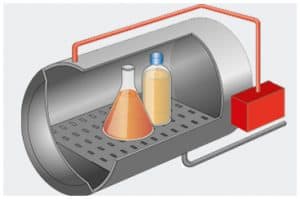
Steam generator Steam generation by steam generator DX
A separate steam generator is incorporated in the housing.This has numerous advantages:
- No heating elements and no reservoir for dirty water in the chamber
- In conjunction with the stand-by pre-heating function, only 10 min. heating time to 121 °C with an empty chamber is required
- Improved air removal by suppressing the air to the bottom with its natural gravitation
- Quicker cooling as neither the hot water in the chamber nor the separate steam generator need to be cooled
- After cooling, steam is immediately available for the next sterilization run
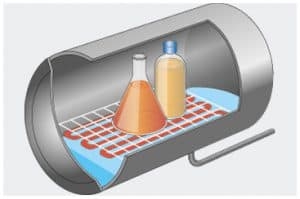
Conventional steam generation Conventional steam generation DE
In this system, powerful heating elements are integrated directly at the bottom of the sterilization chamber. As required, water can be fed in manually or in models DE, demineralized water can be fed in automatically using the DI-Water connection.
Condensation of steam instead of removal DE DX
Exhaust steam is condensed automatically via a PT-100-regulated cooling system. This prevents odors and protects waste water piping that may be made of plastic.
-
Operation
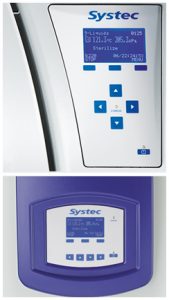
Operation via Display Operation via Display
In all Systec D-Series laboratory autoclaves, control is via a membrane keypad with acoustic confirmation of input. The display is large and easy to read. Everything is logically positioned, ergonomic and easy to operate. Menu operation is in text form, selectable in German, English, French, Spanish and Italian – other languages optional.All control functions are carried out by a specially developed microprocessor. Along with steam pressure, temperature and sterilization time, it also controls all options such as rapid cooling, pre- and post-vacuum and drying.
Available programs*
DX
1– 3 Solids
4 – 5 Waste bags
6 Liquid waste with regulated steam exhaust for cooling
7 Liquid waste with self-cooling
8 –10 Liquids with regulated steam exhaust for cooling
11 Liquids with self-cooling
12 Cleaning
13 Vacuum test**
14 Bowie-Dick Test**
15 – 25 Free for individual programming
DE
1– 3 Solids
4 – 5 Waste bags
6 Liquid waste with regulated steam exhaust for cooling
7 Liquid waste with self-cooling
8 –10 Liquids with regulated steam exhaust for cooling
11 Liquids with self-cooling
12 Cleaning* All programs can be individually parametered.
** Only in combination with vacuum system. -
Safety
Automatic door-opening system
The door is automatically locked by a circumferential ring system*. A special lip seal made of heat-resistant silicone provides reliable tightness; the more the steam pressure increases, the tighter the seal becomes.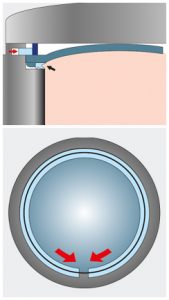
Automatic door-opening system at Systec autoclaves The door-locking system is temperature-dependent according to pressure vessel regulation DIN EN (IEC) 61010-2-040. The door remains locked as long as there is excess pressure in the chamber. The door and other parts of the pressure vessel and housing are made of stainless steel. The attractively designed front cover, which also incorporates the control panel, display and parts of the control processing system, is made of heat-resistant, insulating plastic. There is no risk of the operator coming into contact with hot components.
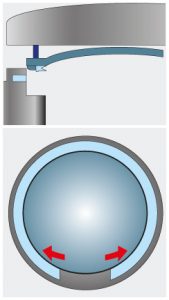 The autoclave door functions automatically – either by pressing a button or for model ranges DX and DE automatically at the end of a program. Residual heat is used to dry the items being sterilized during the final short phase in the autoclave. Automatic door-opening is restricted to an angle of approx. 15°; this avoids possible contamination from the outside. Especially when items to be sterilized have to remain in the autoclave for cooling and drying this facilitates the working process. For removing the sterilized items, the door can be completely opened manually.
The autoclave door functions automatically – either by pressing a button or for model ranges DX and DE automatically at the end of a program. Residual heat is used to dry the items being sterilized during the final short phase in the autoclave. Automatic door-opening is restricted to an angle of approx. 15°; this avoids possible contamination from the outside. Especially when items to be sterilized have to remain in the autoclave for cooling and drying this facilitates the working process. For removing the sterilized items, the door can be completely opened manually.* Exceptions: In the model Systec D-45 the door is closed by means of a bolt.
-
Standards and regulations
Systec autoclaves comply with the following standards and regulations:
Pressure vessel:
- 2014/68/EU Pressure Equipment Directive
- ASME Boiler & Pressure Vessel Code, Section VIII, Division 1
- China Stamp
Other guidelines:
- 2014 / 35 / EU Low Voltage Directive
- 2014 /30 / EU on Electromagnetic Compatibility
All autoclaves are CE marked.
We will be happy to provide a complete list of standards and summary of regulations on request.
-
 Sterilization load and sterilization process
Sterilization load and sterilization process
Select the right process for every sterilization application
Several options are available that are necessary to obtain correct and validatable results and rapid cooling times. A validatable sterilization process of biological efficiency can only be obtained if the correct instrument configuration is used.The table below provides help in establishing the desired configuration; however, we recommend obtaining additional advice from our experts.
Ventilation Cooling Drying Other Gravitation Simplepre-vacuumPulsed excesspressureFractionatedpre-vacuumConventionalcooling withslow pressurereleaseRapid coolingsystem withsupportpressureSurface dryingwithoutvacuumDrying withsubsequentvacuum+ SuperdryExhaust airfiltrationLiquids + ? – – ? + ? – Unpacked non hollow items+ + + + ? + Porous materials (filters, fabrics)– ? ? + + Hollow items (pipette tips,empty glassware, tubesand hoses)– – – + – + Contaminated waste indestruction bags– – ? + – – + + Recommended procedure ? Possibly acceptable – Not possible
-
 Sterilization of liquids
Sterilization of liquids
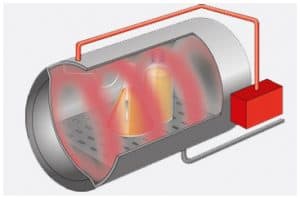
Heating up Heating up
The actual sterilization time of e.g. 15 minutes at 121 °C is only a fraction of the total time involved for an autoclave procedure. Especially in the case of sterilizing liquids, the heating up and cooling down phases are considerably longer.The conventional procedure
In previously used conventional systems, even if the intended sterilization temperature has been reached within the autoclave, the liquids to be sterilized are often only at about 60-90 °C; the temperature equilibrium time between chamber and liquids normally takes much longer.Up to 50 % shorter heat-up times as standard
Due to the combined temperature and pressure regulation, the chamber pressure is increased during the heat-up phase. The result: more rapid temperature equilibrium in the liquids and a shorter heat-up time.
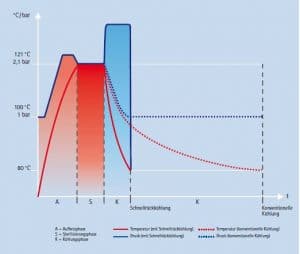
Conventional cooling vs. rapid cooling Cooling
The cooling process for liquids is also very slow; this is because, without active rapid cooling, the heat can only be reduced to below 100°C by dissipating the heat via the chamber insulation by radiation (see diagram). New system- and process technology now make it possible to substantially reduce the overall time required for the sterilization process.Systec supplies autoclaves guaranteeing precise sterilization processes, safe handling and increased productivity. Various optional rapid cooling systems enable the cooling times for liquids to be significantly reduced. This conserves culture media and makes for efficient utilization of the autoclave.
In addition to conventional cooling by regulated steam exhaust down to 100 °C and subsequent very slow self-cooling down to 80 °C, optional cooling systems for rapid cooling are available.
- Cooling with ambient air ventilation
- Mantle cooling with cooling water
- Mantle cooling with cooling water and support pressure
- Radial ventilator for air circulation and accelerated heat removal from the chamber
- Ultracooler
- Spray cooling with recirculated and recooled sterile water and support pressure
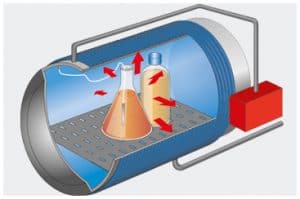
Mantle cooling with cooling water and support pressure Mantle cooling with cooling water and support pressure DX DE
During the entire sterilization process a flexible PT-100 temperature sensor monitors the temperature in a reference vessel. It is thus guaranteed that the sterilization period begins only once the sterilization temperature has been attained in the liquid to be sterilized. The cooling temperature is also constantly monitored. In accordance with relevant standards to prevent delayed boiling, the lid can only be opened once the temperature of the liquid has been reduced to at least 80 °C. The use of support pressure in the form of sterile-filtered compressed air during the cooling phase reliably prevents the culture medium from boiling.Advantages:
- No loss of liquid due to boiling of the culture media
- Improved productivity from reduced cycle times and the full utilization of the filling volume in each bottle
- Prevention of delayed and over-boiling
- Prevention of the risk of bottles bursting during or after sterilization
- Prevention of re-contamination by the use of hermetically sealed bottles during sterilization
- Reduction of cooling time by up to 60 %
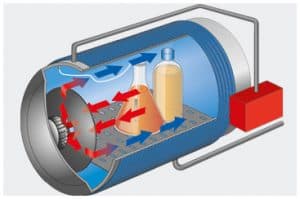
Radial ventilator Radial Ventilator DX DE
In conjunction with optional mantle cooling with cooling water and support pressure, the radial ventilator ensures accelerated removal of heat from the sterilization items to the cooled chamber mantle.- The radial ventilator is placed in the lid of the chamber
- Ventilation performance 71 m3/h
- Reduction of cooling time by up to 70 %
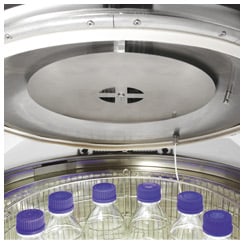
Systec Ultracooler Ultracooler DX DE
In conjunction with optional mantle cooling with cooling water, support pressure and radial ventilator, it is possible to significantly reduce the recooling time and the entire sterilization process by integrating of the additional ultracooler heat exchanger.- The ultracooler is placed in the lid of the chamber near the radial ventilator so that the usable space in the autoclave is not reduced
- Reduction of cooling time by up to 90 %
- Depending on the load, cooling times between 15 and 60 minutes can be achieved
-
 Sterilization of solids
Sterilization of solids
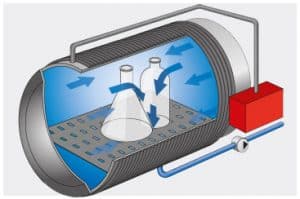
Vacuum system Vacuum system DX
Typical solids are pipette tips (in boxes), empty glassware and porous materials such as filters or fabrics. The vacuum device effectively removes the air from solids, tubing, porous materials, and fabrics, allowing the steam to penetrate completely. The process includes a fractionated pre-vacuum phase in combination with the standard steam generator.
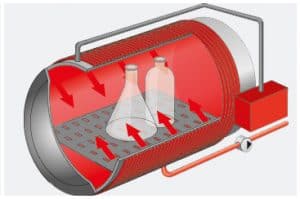
Superdry Superdry – for drying solids DX
This optional accessory increases the drying efficiency for solids and porous materials such as filters and fabrics. Heat energy from the standard steam generator is transferred to the heating coils around the body of the sterilization chamber and is used for drying. Deep-vacuum drying using the optional vacuum device in conjuction with Superdry avoids the necessity for subsequent drying in a separate drying cabinet. -
 Sterilization of waste in disposal bags
Sterilization of waste in disposal bags
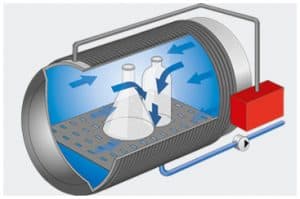
Vacuum system Vacuum system DX
For the of sterilization of waste bags it is important to remove all air from the products to be sterilized to ensure precise, reproducible and validatable sterilization. The vacuum device effectively removes the air from disposal bags, allowing the steam to penetrate completely. The process includes a fractionated pre-vacuum phase in combination with the standard steam generator.
-
 Sterilization of hazardous biological substances
Sterilization of hazardous biological substances
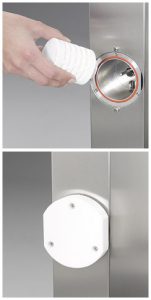
Exhaust air filtration with condesate inactivation Exhaust air filtration with condensate inactivation
For the sterilization of hazardous biological substances, Systec autoclaves can be fitted with an optional air exhaust filtration system. The autoclavable sterile filter, consisting of a filter cartridge with PTFE membrane of pore size 0.2 μm, is installed in a presure-proof housing and can be quickly changed at any time. The filter is also automatically sterilized inline during the sterilization process, monitored by the PT-100 temperature sensor.The condensate is retained inside the pressure vessel during the heating and sterilization phases and thus also sterilized. This ensures that all gases and liquids representing a hazard if they were to be released into the atmosphere are filtered and sterilized in-line.
-
Additional options
Temperature and pressure range extension DX
Systec D-Series autoclaves are equipped for higher temperatures and pressures. The pressure vessel is designed for operations at 150 °C and 5 bar absolute pressure. Optional temperature and pressure range extension accessories adapt all control and safety components to the higher temperature and pressure. Exception: This option is not available for Systec D-23 and Systec D-45. Systec D-23 autoclaves are equipped only for 136 °C and 3.8 bar absolute pressure.
-
Options for documentation
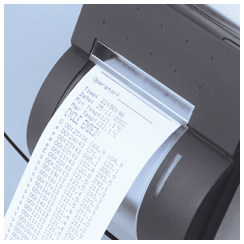
Printer DX DE
Optional integrated printer for documentation of program type, batch number, date / time, temperature / pressure progress and sterilization phase.
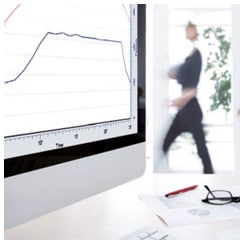
Systec ADS Documentation Software Systec ADS Documentation Software package DX DE
Via RS-232 interface for direct connection to a PC or for connecting to an Ethernet network via converters.
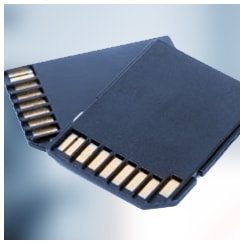
SD card SD card for batch documentation* DX DE
Extensive documentation on up to 10,000 sterilization cycles* via an (optional) integrated card slot and a 1024 MB SD memory card (included).
* only in conjunction with optional Systec ADS software. -
Options for process optimization

Mantle cooling with cooling water and support pressure Mantle cooling with cooling water and support pressure DX DE
During the entire sterilization process a flexible PT-100 temperature sensor monitors the temperature in a reference vessel. In accordance with relevant standards to prevent delayed boiling, the lid can only be opened once the temperature of the liquid has been reduced to at least 80 °C.

Radial ventilator Radial Ventilator DX DE
In conjunction with optional mantle cooling with cooling water and support pressure, the radial ventilator ensures accelerated removal of heat from the sterilization items to the cooled chamber mantle.- Reduction of cooling time by up to 70 %

Ultracooler Ultracooler DX DE
In conjunction with optional mantle cooling with cooling water, support pressure and radial ventilator, it is possible to significantly reduce the recooling time and the entire sterilization process by integrating of the additional ultracooler heat exchanger.- Reduction of cooling time by up to 90 %
- Depending on the load, cooling times between 15 and 60 minutes can be achieved

Superdry Superdry – for drying solids DX
This optional accessory increases the drying efficiency for solids and porous materials such as filters and fabrics. Heat energy from the standard steam generator is transferred to the heating coils around the body of the sterilization chamber and is used for drying. Deep-vacuum drying using the optional vacuum device in conjuction with Superdry avoids the necessity for subsequent drying in a separate drying cabinet.

Vacuum system Vacuum system DX
The vacuum device effectively removes the air from solids, tubing, porous materials, and fabrics, allowing the steam to penetrate completely. The process includes a fractionated pre-vacuum phase in combination with the standard steam generator. -
Accessories
Loading baskets and inserts

Stainless steel wire mesh baskets, stackable
Loading shelves DX

To fully utilize the available space in the chamber, especially when sterilizing small items, the autoclaves can be fitted with loading shelves.

Support Tables
There is a special bench for each of the Systec D-Series autoclaves. The benches are 72 cm high (other heights available at no extra charge) and make for ease of handling. They have a practical shelf e.g. for storing baskets etc.

Transport and loading trolley DX
Large autoclaves in particular can be easily and securely loaded using a special loading trolley. The items to be sterilized can either be placed directly on the sliding platform of the trolley or using a basket. The trolley can now be moved and docked to the autoclave and fixed in position. The handle can then be loosened to allow the platform to slide into the autoclave on fixed rails.We are happy to help you to find the optimal autoclave including options and accessories!

